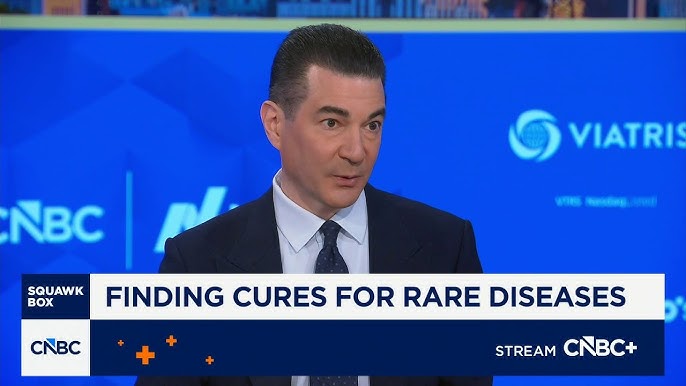
Dr. Scott Gottlieb on Finding Cures for Rare Diseases
Former FDA Commissioner Dr. Scott Gottlieb joins ‘Squawk Box’ to discuss the ongoing research and efforts at the FDA to find cures for rare diseases.…
Thought Leader: Scott Gottlieb
Modernizing CMS to Enhance Access to Innovation
The American free market is the world’s cradle for medical innovation, giving rise to the latest advances in medicine such as novel platforms for gene editing, cancer immunotherapy, and percutaneous cardiac valve intervention. Unfortunately, outdated government laws may imperil both individual access to new products and innovator capacity for developing new technologies. America’s elderly are uniquely vulnerable to these constraints on the market and medicine due to their growing chronic disease burden. As America’s largest payer, the Centers for Medicare & Medicaid Services (CMS) is entrusted with securing access to timely and clinically necessary innovations for Medicare beneficiaries. By advancing innovation in health care, we can unlock crucial drivers for long-term cost reductions and quality improvements for our beneficiaries.
Novel technologies require an ecosystem that enables new products – once approved by the Food and Drug Administration (FDA) – to be readily accessible for beneficiaries. In other words, the hardest hills for innovators to climb should be scientific, not bureaucratic. However, for too long, the gears of American medical innovation have rusted due to a web of laws that may limit the uptake of transformative technologies into clinical practice. The axiom, “the law lags behind technology” is distressingly true in American medicine, with a 20th century system that may not provide sufficient incentives for providers to use the 21st century medical advances needed to care for our growing Medicare population. The vocabulary used to write the law’s outdated definitions for coverage never anticipated the diverse spectrum of medical innovation, from software-integrated devices with real-time capabilities to genetic technologies with curative potential. To illustrate how the law and its interpretation may limit innovation, consider diabetes, an epidemic impacting millions of Americans that costs taxpayers nearly a quarter of a trillion dollars each year. Although innovators have risen to the challenge, the gap between the cutting-edge of care and the law’s obsolete definitions that guide coverage and other decisions is growing, stymying patient access to new products. For example, bureaucratic interpretation of the law resulted in a delay in Medicare’s ability to pay for disposable insulin pumps as compared with private payers. In another case, this prevented Medicare from paying for a glucometer if it was used with a web-based mobile application (a technology that was not conceived of when Congress initially defined the parameters of durable medical equipment).
CMS is beholden to a cumbersome web of statutory constraints on coding, coverage, and payment which may hinder innovation and the efficiency of agency operations. For example, statutory reforms of the laws governing antibiotic development at the FDA – which are critically important for Medicare beneficiaries due to the growing problem of antimicrobial resistance – have resulted in accelerated reviews and special product designations. However, until recently, FDA-approved antibiotics lacked a viable business proposition due to the misalignment of incentives within Medicare’s outdated payment system for antimicrobials. This is because the laws governing inpatient payment for antimicrobials rely on diagnosis related groups (DRGs), which bundle together payment for therapeutics and hospital services to facilitate cost control. In doing so, the law may have undervalued new (and initially, more expensive) antibiotics and instead incentivized the use of cheaper drugs which may not have been developed with the intent of addressing resistance. This has prompted a massive exodus of innovators from this marketplace.
Implementing reforms requires a careful understanding of the regulatory journey of a new innovation. Innovative FDA-approved products (e.g., breakthrough medical devices) are evaluated by CMS to determine the scope of coverage for the new technology (local versus national). CMS then works with providers to determine whether the new technology fits with an existing code or requires a new code. The regulatory journey ends with payment, with CMS required to navigate the laws governing Medicare payment. These laws create a complex payment hierarchy that depends on provider type and care setting. For example, Medicare pays for inpatient treatments using DRGs, but reimburses the same technology differently if delivered in an outpatient setting. If the product can be provided in a beneficiary’s home and meets certain criteria, it may be paid under the Durable Medical Equipment benefit.
The government’s existing laws may be unequipped to handle recent technological developments whose novel nature and unprecedented prices may operate beyond the scope of our current regulatory paradigm. For example, payers – such as CMS – are historically accustomed to paying for drugs for chronic diseases in a volume-based manner, with competition from generics, biosimilars, and new molecular entities gradually effecting changes in price. Many medications focus on symptom alleviation or disease management, stretching payments for months or years depending on the condition. The law’s outdated approach to payment may not provide sufficient flexibility to prepare for the advent of one-time, potentially curative gene therapies with large price tags. FDA is expected to approve 40 such gene therapies by 2022, whose high prices will likely be insulated from market competition due to the projected clinical benefit of new treatments. While potentially life-saving for patients, the possible multimillion dollar prices of these drugs could be deadly for our current payment systems.
These recent examples – diabetes technologies, antibiotics, gene therapies – underscore how the government has consistently struggled to keep up with medical advances in the marketplace. We cannot rely on bureaucrats to bend the curve on innovation. Some folks have even proposed a complete government takeover of healthcare through Medicare for All which would halt American creativity and ingenuity without the transparency and accountability that private payers bring to the marketplace. Simply put, Medicare for All would lead to innovation for none.
CMS thus faces the challenge of safeguarding each beneficiary’s ability to access innovative care while recognizing the market pressures on manufacturers to set prices reflecting the cost of innovation. The Trump Administration is fostering innovation and supporting beneficiaries’ access to transformative technologies. Through the final FY 2020 Inpatient Prospective Payment System (IPPS) rule, we have removed a number of disincentives to antimicrobial innovation that will apply to discharges at approximately 3,300 acute care hospitals and approximately 390 long-term care hospitals. Our policy actions include an increase in the New Technology Add-On Payment (NTAP) for innovations such as CAR-T cell therapy. CMS also developed a new NTAP pathway for technologies which receive Breakthrough Device status from FDA to accelerate their entry into the market, in which these devices would no longer need to meet the NTAP substantial clinical improvement requirement. These changes will expedite access to the latest innovations for Medicare beneficiaries and better align CMS policy with FDA designations. To provide innovators with regulatory predictability, CMS asked the public to help the agency define substantial clinical improvement to further reduce regulatory obstacles for innovators developing new technologies. To increase regulatory transparency beyond the IPPS proposal, CMS will now issue HCPCS codes on a quarterly basis for drugs and a semi-annual basis for devices as opposed to the existing once-a-year window.
The Trump Administration recognizes the challenges that lie ahead with new medical advances that test the limits of existing regulation. President Trump’s historic Executive Order on protecting and improving Medicare outlines a number of bold and comprehensive policies to advance medical innovation and ultimately make novel medical products more widely available to patients without delay. Specifically, we are determined to close the regulatory gap between FDA and CMS by implementing policy reforms that increase the consistency of coverage policies to create transparency and predictability for innovators beginning the journey from bench to bedside. To achieve these aims, we are exploring, for example, how CMS can better leverage real-world evidence to inform our decision-making and ease regulatory burden for innovators. And, in coming months, CMS will make wholescale improvements to how we engage with innovators and other stakeholders.
At CMS, we are committed to orienting our regulatory paradigm around the needs of patients. CMS’s recent actions highlight the Trump Administration’s commitment to both ensuring patient access to innovation and unleashing the free market’s ability to produce new technologies. By strengthening the natural nexus between medicine and the market, we are reinforcing America’s position as the global leader in innovation, while advancing our goal of improving the health and lives of our beneficiaries.
Dr. Scott Gottlieb on Finding Cures for Rare Diseases
Former FDA Commissioner Dr. Scott Gottlieb joins ‘Squawk Box’ to discuss the ongoing research and efforts at the FDA to find cures for rare diseases.…
Thought Leader: Scott Gottlieb
Peter Zeihan: U.S. Navy Seizes Russian Tanker
The US Navy just seized a shadow fleet tanker that managed to slip past the naval quarantine around Venezuela. The tanker reflagged as Russian while…
Thought Leader: Peter Zeihan
Erika Ayers Badan: Surviving Company Failure
In this episode of WORK: Unsolicited Advice, Erika talks through what it really looks like to come out of the worst month of your career…
Thought Leader: Erika Ayers Badan

